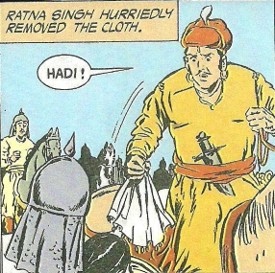Talk:Hādī Rānī: Duty before One’s Life
By Vishal Agarwal
In the 17th century, during the reign of Mahārāṇā Rāj Siṅgh of Mewār (1653–1680), the Mughal emperor Aurangzeb was expanding his power across Rajasthan. To resist him, the Mahārāṇā called upon his brave chiefs. Among them was Rāo Ratan Siṅgh Chundāwat of Sālumber.
At that time, Ratan Siṅgh had just married the young princess Hādī of Buṇḍī. He wished to stay with his new bride, but duty called him to the battlefield. Torn between love and loyalty, he hesitated.
Seeing his conflict, Hādī Rānī reminded him of their Rajput code: honor and duty always come before personal desires. She told him that a Rajput should never allow hesitation to tarnish their name, especially when the land and its honor were at stake.
Encouraged, Ratan Siṅgh set out for war. Yet, on the way, he felt his heart still pulling him back to his bride. He sent her a message, asking for a keepsake—something he could carry as a reminder of her.
When Hādī Rānī received the message, she made a shocking decision. She asked for a sword and a plate. Before anyone could stop her, she cut off her own head and placed it on the plate, covered with a cloth. She sent it to her husband as the “memento” he had asked for.
When Ratan Siṅgh uncovered the plate, he was struck with grief but also overwhelmed with pride at her sacrifice. Filled with determination, he charged into battle against the Mughals with unmatched courage. He fought fiercely, inspired by his wife’s last act of devotion.
After the victory, however, he felt life had no meaning without her. In the spirit of Rajput loyalty and love, he took his own life, choosing to join Hādī Rānī in death.

